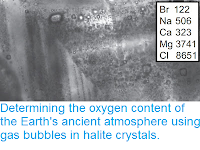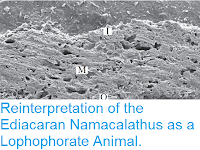The Weng’an Biota is a fossil lagerstätten from the Early Ediacaran of South China. The fossils are found in the Doushantuo Formation, which outcrops in Weng'an County of Guizhou Province, and date to between 551 and 635 million years ago, being very likely to be older than 609 million years old. This makes them older than the macrofossils of the Ediacaran Biota, but after the predicted date for the appearance of the earliest animals, a particularly interesting time-interval for palaeontologists studying the origin of both animals in general and moder animal groups. The biota contains both macro- and microfossils, with the macrofossils preserved as two-dimensional carbonaceous compression fossils and the microfossils preserved as silicified three dimensional replacement fossils. A number of putative animal fossils have been described from the Weng’an Biota, including a possible Ctenophore and a number of microfossils comprising balls of cells, that have been identified as possible animal embryos. However none of these fossils has been universally accepted as a definite animal, making the presence of animals in the Weng’an Biota debatable.
In a paper published in the Journal of the Geological Society on 3 May 2017, John Cunningham of the School of Earth Sciences at the University of Bristol and Department of Palaeobiology and Nordic Center for Earth Evolution at the Swedish Museum of Natural History, Kelly Vargas, also of the School of Earth Sciences at the University of Bristol, Zongjun Yin of the State Key Laboratory of Palaeobiology and Stratigraphy at the Nanjing Institute of Geology and Palaeontology, Stefan Bengtson, also of the Department of Palaeobiology and Nordic Center for Earth Evolution at the Swedish Museum, and Philip Donoghue, again of the School of Earth Sciences at the University of Bristol, review the fossils of the Weng’an Biota, and consider the possibility that any of these fossils might be of animal origin.
Firstly Cunningham et al. consider a group of macro-fossils from the Weng’an Biota that have previously been described as Algae. They note that some of these fossils do resemble modern algal groups, notably Archaeophycus, which resembles modern Bangialean Red Algae, and Thallophyca and Paramecia, which resemble living Floridophyte Red Algae. However, while these forms resemble modern Algal groups, many of the fossils described as 'Algae' have no clear affinity with any algal group, and indeed are quite un-algal in form, being roughly globular rather than flattened, a shape quite unsuitable for a photosynthetic organism. Cunningham et al. note that the term 'Algae' has often been used as a 'wastebasket' for fossils that are hard to assign to any particular group. They note that many of these organisms may not actually have been Algae, though their actual identity is unclear, and they may represent the adult forms of some of the 'embryo' fossils that have been identified from the Weng’an Biota.
Synchrotron radiation X-ray tomographic microscopy of a possible Alga, comparable with Paramecia. Cunningham et al. (2017).
Next Cunningham et al. examined the Acritarchs of the Weng’an Biota. Acritarchs are unicellular Eukaryotic organisms (organisms with cells with a discrete nucleus) that appear in the fossil record from about 3200 million years ago until the end of the Permian. They're affinities are unclear, and the group is probably paraphyletic (not all members sharing a common ancestry), though the majority are thought to have been unicellular planktonic Algae or the resting cysts of other unicellular organisms. The Achritarchs of the Weng'an Biota are as ambivalent as those from other deposits, though some have been described as containing what appear to be examples of the Weng'an embryo-like fossils, raising the possibility that these might be different life-stages of the same organism.
Mengeosphaera, an Acritarch from the Weng'an Biota. Cunningham et al. (2017).
Next Cunningham et al. consider the putative embryo-like fossils. These are spherical balls of cells that have been suggested to be the early stage embryos of animals, or even Bilaterians (animals which have evolved bilateral symmetry - essentially all animals except Sponges, Cnidarians and Ctenophores - all Bilaterians are thought to share a single common ancestor), as well as potentially members of other very different groups, such as Giant Sulphur Bacteria or colonial Ciliates. Cunningham et al. regard all of these specimens as likely to belong to a single species, Tianzhushania, but do not see any evidence to support any of the proposed affinities of the group, noting that most of the features that have been used to assign them to particular groups are actually found in a variety of organisms. They also note that some Peanut-shaped fossils that have been described from the deposits appear similar to these embryo-like fossils, possibly representing a different stage in the life of the same organism. This could possibly suggest that these fossils are propagules of this larger organism, suggesting a lifestyle quite unlike that of any animal.
Next Cunningham et al. look at possible Sponge fossils from the Weng'an Biota. Sponges are the simplest form of animal alive today, lacking any true tissue differentiation, and DNA analysis has revealed that they are the outgroup to all other animals (i.e. all other animals are more closely related to one-another than they are to Sponges).They are therefore predicted to be the first animal group to appear in the fossil record, with possible Sponge fossils described from a number of Precambrian localities. A number of potential siliceous Sponge spicules have been described from the Weng'an Biota, though these have subsequently been shown not to have originally been siliceous in nature, and do not have any characteristics which can be used to confidently identify them as having come from a Sponge, making their origin uncertain. A single specimen of what appears to be an entire Sponge has also been described from the Weng'an Biota; Eocyathispongia is considered to be one of the best candidate Sponge fossils from the Precambrian. However while this fossil appears Sponge like in general form, Cunningham et al. could see any definitive Sponge features, such as pores or spicules, on the specimen, making it impossible to confidently assign it to this group.
Next Cunningham et al. examine a group of tubular microfossils, which have previously been identified as possible Tabulate Corals. However closer examination of these fossils suggests there were biological structures in the space between the tabular walls where the polyp would have been expected to have lived, making the assignment of these fossils to the Tabular Corals impossible.
Finally Cunningham et al. look at Vernanimalcula, a fossil from a thin section of rock (i.e. slice of rock prepared for a microscope slide) which has been suggested as a possible Bilaterian, with features such as a mouth, gut, anus and paired coelomic cavities. However identification of such structures in thin section is notoriously unreliable, and Cunningham et al.suggest that a variety of both biological and non-biological structures could give this appearance if sliced through at the right angle.
Cunningham et al.conclude that none of the Weng'an Biota fossils can be confidently assigned to any Animal group, and that attempts to assign these pre-Ediacaran Biota fossils to modern groups is probably unwise. Nevertheless the site does provide a valuable insight into the emergence of multi-cellular Eukaryotic organisms prior to the appearance Ediacaran Biota, and that further study of these fossils is likely to prove valuable if carried out with an open mind.
See also...
Scanning electron microscope images of Tianzhushania specimens at various stages of division from a single cell (a) to many hundreds of cells (f ). Scale bar: (a) 320 μm, (b) 265 μm, (c) 265 μm, (d) 200 μm, (e) 245 μm, (f ) 280 μm. Cunningham et al. (2017).
Next Cunningham et al. look at possible Sponge fossils from the Weng'an Biota. Sponges are the simplest form of animal alive today, lacking any true tissue differentiation, and DNA analysis has revealed that they are the outgroup to all other animals (i.e. all other animals are more closely related to one-another than they are to Sponges).They are therefore predicted to be the first animal group to appear in the fossil record, with possible Sponge fossils described from a number of Precambrian localities. A number of potential siliceous Sponge spicules have been described from the Weng'an Biota, though these have subsequently been shown not to have originally been siliceous in nature, and do not have any characteristics which can be used to confidently identify them as having come from a Sponge, making their origin uncertain. A single specimen of what appears to be an entire Sponge has also been described from the Weng'an Biota; Eocyathispongia is considered to be one of the best candidate Sponge fossils from the Precambrian. However while this fossil appears Sponge like in general form, Cunningham et al. could see any definitive Sponge features, such as pores or spicules, on the specimen, making it impossible to confidently assign it to this group.
Eocyathispongia, a putative Sponge from the Weng'an Biota. Cunningham et al. (2017).
Next Cunningham et al. examine a group of tubular microfossils, which have previously been identified as possible Tabulate Corals. However closer examination of these fossils suggests there were biological structures in the space between the tabular walls where the polyp would have been expected to have lived, making the assignment of these fossils to the Tabular Corals impossible.
Sinocyclocyclicus, a putitative Tabulate Coral from the Weng'an Biota. Cunningham et al. (2017).
Finally Cunningham et al. look at Vernanimalcula, a fossil from a thin section of rock (i.e. slice of rock prepared for a microscope slide) which has been suggested as a possible Bilaterian, with features such as a mouth, gut, anus and paired coelomic cavities. However identification of such structures in thin section is notoriously unreliable, and Cunningham et al.suggest that a variety of both biological and non-biological structures could give this appearance if sliced through at the right angle.
Cunningham et al.conclude that none of the Weng'an Biota fossils can be confidently assigned to any Animal group, and that attempts to assign these pre-Ediacaran Biota fossils to modern groups is probably unwise. Nevertheless the site does provide a valuable insight into the emergence of multi-cellular Eukaryotic organisms prior to the appearance Ediacaran Biota, and that further study of these fossils is likely to prove valuable if carried out with an open mind.
See also...
Follow Sciency Thoughts on Facebook.











